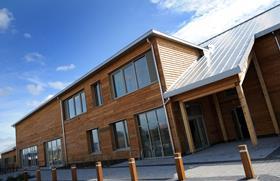Draft design guidance reveals BREEAM for schools still ŌĆśunder reviewŌĆÖ just weeks from launch of school building programme

The requirement for schools to achieve BREEAM sustainability ratings is still under review just weeks before the governmentŌĆÖs major school building programme is due to be launched.
Draft design guidance produced by the governmentŌĆÖs schools delivery body the Education Funding Agency (EFA), seen by ║├╔½Ž╚╔·TV, includes a clause stating that design teams should ŌĆ£report the environmental impact of the project using BREEAM 2011 for schools, or equivalent, with a rating of very goodŌĆØ.
However, this clause is followed by a note stating that this is still ŌĆ£under reviewŌĆØ.
This is despite the fact that last week schools minister Nick Gibb told parliament that the ŌĆ£outcome of applicationsŌĆØ for the long-awaited ┬Ż2bn Priority Schools ║├╔½Ž╚╔·TV Programme (PSBP) - which is three times oversubscribed - would be announced this month after a six-month delay.
Gibb is expected to announce around 30 schools will be taken forward in the first wave of the programme, which was set up in place of the previous governmentŌĆÖs ┬Ż55bn ║├╔½Ž╚╔·TV Schools for the Future programme, scrapped by ministers in 2010. Procurement, initially expected in April, is now set to get underway in September.
Education secretary Michael Gove put the BREEAM requirement under review following the James Review of schools capital, which singled out the BREEAM regulations for criticism, citing the excessive burden of regulation and guidance in procurement and high costs for carrying out pre-assessment of BREEAM for schools.
However, the move to scrap green standards for new school buildings prompted an industry backlash and has divided Whitehall, with the Department for Business, Innovation and Skills, the Department for Environment, Food and Rural Affairs and the Department for Energy and Climate Change all lobbying GoveŌĆÖs department over the issue.
Concern over the green schools policy were heightened last month after ║├╔½Ž╚╔·TV published the results of a comprehensive built under the previous government, which found that a third of schools were judged to be ŌĆ£unsatisfactoryŌĆØ in terms of their sustainability, while the vast majority had failed to meet the required energy efficiency standards.
Speaking at the BFE conference in London today Peter Lauener, EFA chief executive, said many schools built under the previous government ŌĆ£used more energy than they should have doneŌĆØ. ŌĆ£We have to ensure new schools donŌĆÖt make the same mistakes,ŌĆØ he said.
The draft design guidance, dated April 2012, also lays out a standardised approach for schools, saying that under the PSBP schools will be procured in groups and sample designs should be able to be used as a basis for all schools in a group.
However, it stops short of endorsing a particular standardised design, with the government now favouring an approach that sets out basic recommendations on the specifics of school design and stops short of setting rigid specifications for school building.
At the BFE conference, Lauener said: ŌĆ£IŌĆÖm concerned standardisation means different things to different people. I donŌĆÖt want educational buildings to experience groundhog day. But we need to realise what is ŌĆśneed to haveŌĆÖ and what is ŌĆśnice to haveŌĆÖ.



























No comments yet